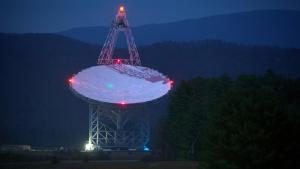Blog
Aliens and Other Things
1 May 2021
 Jiuguang Wang/CC BY-SA 2.0
Jiuguang Wang/CC BY-SA 2.0The Breakthrough Listen project has made several attempts to find evidence of alien civilizations through radio astronomy. Its latest effort focuses attention on the center of our galaxy.1
The idea behind Breakthrough Listen is that if alien civilizations are out there, they probably emit radio signals either intentionally or unintentionally. Most of their work has focused on observing stars with potentially habitable planets, the idea being that just as we emit radio signals, so do they. But by looking at the center of our galaxy, they’ve begun to search for more ambitious aliens.
The central region of our galaxy is a great place to point your telescope if you want to listen for signals across thousands of stars. It’s the region of the Milky Way where stars are most densely clustered. The downside is that the center of the Milky Way falls outside the galactic habitable zone.
 NASA/Caltech
NASA/CaltechFor a planetary system, the habitable zone is defined by a planet’s distance from its star. Too close and water would boil away, too far and it would all freeze. Obviously, things aren’t quite that simple, and life could arise in unexpected places, but it’s a good rough guide. In principle, it shouldn’t matter where a habitable star system is in our galaxy, but on cosmic scales it does. Nearby cataclysmic events such as supernovae and gamma-ray bursts could fry life on a young planet. Since the core region of our galaxy is dense with the kind of large stars that tend to explode, it is likely to be very hostile to life.
However, if you are a galaxy-spanning civilization and want to announce your presence to the universe, then you might put a loud radio transmitter near the center of the galaxy where everyone could hear it. So Breakthrough Listen decided to check it out.
 Gajjar, et al
Gajjar, et alTo do this, the team looked for what are known as radio transients. These are short-duration radio bursts that can be caused by things like magnetars and stellar flares. Since most transients happen randomly in the sky, an alien civilization could stand out by creating radio bursts with regular periodicity, say every few hours or so. Using the Green Bank Telescope in West Virginia and the Parkes radio telescope in eastern Australia, the team gathered 600 hours of radio observations.
As you might expect, they didn’t find evidence of a repeating alien signal. However, their data was robust enough to rule out repeating signals with a period of up to 10 hours or so. Now, maybe the aliens are playing a longer game, but so far they don’t seem to be talking.
Despite the lack of alien signals, the study did find several transient events. These not only help us understand phenomena such as radio-bright magnetars, but they also help us map the distribution of these objects in the central galactic region. It’s a study that serves double duty, and that makes it good for alien seekers and alien skeptics alike.
Vishal Gajjar, et al. “The Breakthrough Listen Search For Intelligent Life Near the Galactic Center I.” arXiv preprint arXiv:2104.14148 (2021). ↩︎